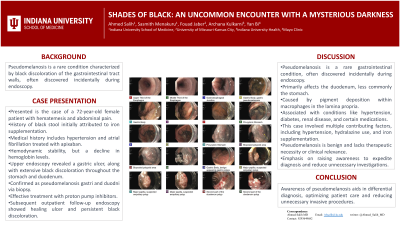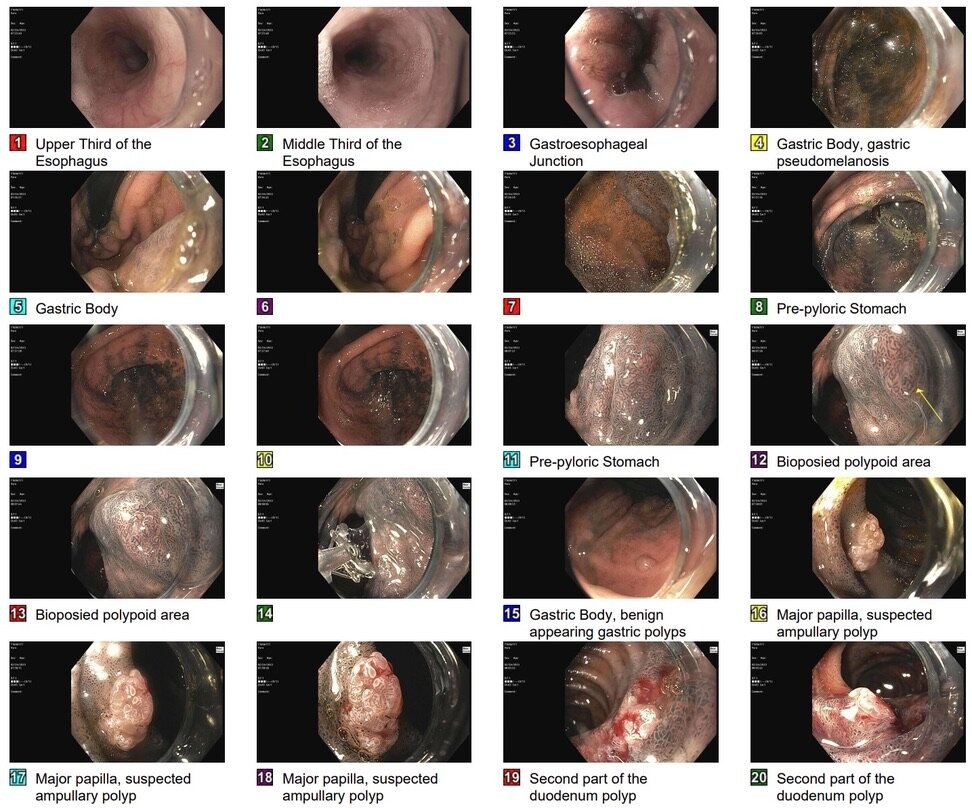Tuesday Poster Session
Category: Small Intestine
P4162 - Shades of Black: An Uncommon Encounter with a Mysterious Darkness
Tuesday, October 24, 2023
10:30 AM - 4:00 PM PT
Location: Exhibit Hall


Ahmed Salih, MD
Indiana University School of Medicine
Muncie, IN
Presenting Author(s)
Ahmed Salih, MD1, Sasmith Menakuru, MD1, Fouad Jaber, MD2, Archana Kulkarni, MD3, Yan Bi, MD, PhD4
1Indiana University School of Medicine, Muncie, IN; 2University of Missouri-Kansas City, Kansas City, MO; 3IU Ball Memorial, Muncie, IN; 4Mayo Clinic, Jacksonville, FL
Introduction: Pseudomelanosis is a rare condition characterized by black discoloration of the gastrointestinal tract walls, typically discovered incidentally during endoscopic examinations. We report a case of a 72-year-old female patient who presented with hematemesis and abdominal pain, ultimately diagnosed with pseudomelanosis.
Case Description/Methods: A 72-year-old female patient presented with a two-day history of coffee ground emesis and diffuse abdominal pain. She reported experiencing black stool for a few months, initially attributing it to iron supplementation. The patient had a history of hypertension and atrial fibrillation treated with apixaban. Upon evaluation, she exhibited hemodynamic stability, although laboratory tests revealed a decline in hemoglobin levels from 11.9 gm/dl a month earlier to 10.6 gm/dl. Physical examination revealed signs of lethargy, pale conjunctiva, and moderate tenderness in the epigastric region. Upper endoscopy unveiled an oozing gastric ulcer that was effectively managed through clipping. Additionally, an incidental finding of extensive black discoloration throughout the stomach and duodenum prompted a biopsy, which confirmed the presence of pseudomelanosis gastri and duodni. The patient responded favorably to treatment and was discharged with proton pump inhibitors. Subsequent outpatient follow-up endoscopy demonstrated a healing ulcer along with persistent black discoloration. Figure 1
Discussion: Pseudomelanosis of the gastrointestinal tract is encountered as an incidental finding during endoscopic examinations. It is a rare condition, with the duodenum being primarily affected, while gastric involvement is further less common. It manifests as a dark discoloration on the smooth mucosal surface, arising from the deposition of pigments within macrophages in the lamina propria, which can be seen histologically. Furthermore, it has been observed to occur more frequently in patients with hypertension, diabetes, renal disease, and prolonged use of specific medications such as iron and sulfide drugs like hydralazine and thiazides. In this particular case, the extensive pigmentation observed was likely influenced by multiple factors, including hypertension, hydralazine usage, and iron supplementation. Notably, pseudomelanosis is a benign entity devoid of any therapeutic necessity or clinical relevance. It is imperative to enhance awareness regarding this condition to facilitate expedient diagnosis and curtail superfluous investigations.

Disclosures:
Ahmed Salih, MD1, Sasmith Menakuru, MD1, Fouad Jaber, MD2, Archana Kulkarni, MD3, Yan Bi, MD, PhD4. P4162 - Shades of Black: An Uncommon Encounter with a Mysterious Darkness, ACG 2023 Annual Scientific Meeting Abstracts. Vancouver, BC, Canada: American College of Gastroenterology.
1Indiana University School of Medicine, Muncie, IN; 2University of Missouri-Kansas City, Kansas City, MO; 3IU Ball Memorial, Muncie, IN; 4Mayo Clinic, Jacksonville, FL
Introduction: Pseudomelanosis is a rare condition characterized by black discoloration of the gastrointestinal tract walls, typically discovered incidentally during endoscopic examinations. We report a case of a 72-year-old female patient who presented with hematemesis and abdominal pain, ultimately diagnosed with pseudomelanosis.
Case Description/Methods: A 72-year-old female patient presented with a two-day history of coffee ground emesis and diffuse abdominal pain. She reported experiencing black stool for a few months, initially attributing it to iron supplementation. The patient had a history of hypertension and atrial fibrillation treated with apixaban. Upon evaluation, she exhibited hemodynamic stability, although laboratory tests revealed a decline in hemoglobin levels from 11.9 gm/dl a month earlier to 10.6 gm/dl. Physical examination revealed signs of lethargy, pale conjunctiva, and moderate tenderness in the epigastric region. Upper endoscopy unveiled an oozing gastric ulcer that was effectively managed through clipping. Additionally, an incidental finding of extensive black discoloration throughout the stomach and duodenum prompted a biopsy, which confirmed the presence of pseudomelanosis gastri and duodni. The patient responded favorably to treatment and was discharged with proton pump inhibitors. Subsequent outpatient follow-up endoscopy demonstrated a healing ulcer along with persistent black discoloration. Figure 1
Discussion: Pseudomelanosis of the gastrointestinal tract is encountered as an incidental finding during endoscopic examinations. It is a rare condition, with the duodenum being primarily affected, while gastric involvement is further less common. It manifests as a dark discoloration on the smooth mucosal surface, arising from the deposition of pigments within macrophages in the lamina propria, which can be seen histologically. Furthermore, it has been observed to occur more frequently in patients with hypertension, diabetes, renal disease, and prolonged use of specific medications such as iron and sulfide drugs like hydralazine and thiazides. In this particular case, the extensive pigmentation observed was likely influenced by multiple factors, including hypertension, hydralazine usage, and iron supplementation. Notably, pseudomelanosis is a benign entity devoid of any therapeutic necessity or clinical relevance. It is imperative to enhance awareness regarding this condition to facilitate expedient diagnosis and curtail superfluous investigations.

Figure: Figure 1
Disclosures:
Ahmed Salih indicated no relevant financial relationships.
Sasmith Menakuru indicated no relevant financial relationships.
Fouad Jaber indicated no relevant financial relationships.
Archana Kulkarni indicated no relevant financial relationships.
Yan Bi indicated no relevant financial relationships.
Ahmed Salih, MD1, Sasmith Menakuru, MD1, Fouad Jaber, MD2, Archana Kulkarni, MD3, Yan Bi, MD, PhD4. P4162 - Shades of Black: An Uncommon Encounter with a Mysterious Darkness, ACG 2023 Annual Scientific Meeting Abstracts. Vancouver, BC, Canada: American College of Gastroenterology.
